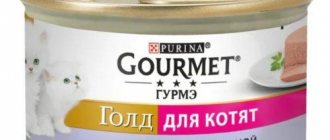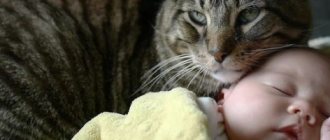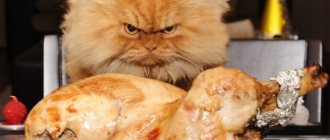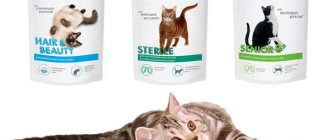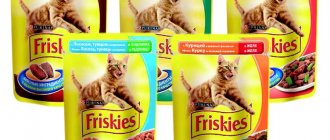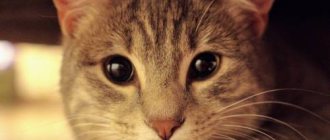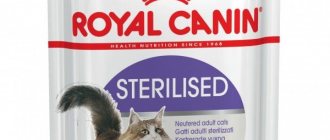A cat is a “convenient” pet for an apartment and irreplaceable in a private home... A cat can often truly feel a person - guess his mood and thoughts. But these animals, in turn, need human care - it is especially worth paying due attention to their diet, because, as a rule, our pets (especially purebred ones) need special vitamins and minerals that are not always present in “table food”. In addition, our mustachioed pets may be susceptible to eating disorders or other diseases associated with poor diet.
In general, for an animal to be healthy, you need to be able to select a feeding regimen and a balanced set of foods for it.
Features of the cat's body
To understand how and what is best to feed your cat, you should know how its body works. First of all, it is important to understand that a cat is a born predator. Its jaws are designed in such a way that it tears its food. But this domestic animal does not have chewing teeth, and this is the key difference between a cat and omnivores.
Cats do not like cold food, because like any carnivorous animals, they are accustomed to eating their prey warm, immediately after being caught.
Cats are leisurely and quite picky eaters. Often, in the process of eating, an animal discards particles that it, for one reason or another, does not like. Knowing this, manufacturers use higher quality ingredients for cat food than for dogs.
For purring pets, the taste and smell of food is extremely important. For this reason, cat foods are more flavorful than dog food. In addition, cats are happy to try food with new tastes, so animals that refuse food should be offered food with a new taste. In most cases this works great.
Important! Cats, unlike other animals, do not distinguish sweet tastes. When choosing food for them, consistency, moisture and particle size are of greater importance.
What type of diet to choose for a cat
You can feed your furry pet dry or wet food, or you can prepare natural food for your cat yourself. Each option has its own advantages and disadvantages. Let's study them.
Feeding with dry food
Today this is the most common type of nutrition. It has many obvious advantages, and first of all, this food is complete and balanced for the specific age and weight of your pet.
The food does not need to be prepared; you just need to pour the required amount of granules into a bowl and place water nearby so that the cat can drink. Unlike natural food, the granules will not spoil even if they lie in a bowl for two days, which is also an advantage of this type of food.
Important! Some owners have a prejudice against dry food. In their opinion, such food is harmful to the animal. Veterinarians respond to this that only economy-class food can harm a cat, while high-quality products meet all the needs of the cat’s body.
The only disadvantages of this approach to nutrition include the high cost of high-quality feed. In addition, given that dry food contains a minimum of liquid, it is important to ensure that the animal always has a bowl of clean water.
Feeding factory wet food
If you are against dry food, you can stick to wet food. But things are not so simple here.
Not all wet canned foods are complete, which means that their composition is not completely balanced.
Many canned cat foods indicate that the product is a supplementary food. That is, it is used for mixed feeding.
This type of feeding has disadvantages, the most important of which are:
- High cost of wet food. One pouch of such food or canned packaging of the product will cost at least 70 rubles, and more often even more expensive. If you feed this food constantly, keeping a cat will cost a pretty penny. Of course, we are talking about high-quality food, and not mass-market food for 15 rubles apiece.
- In addition, such food will not always be complete. You need to pay attention to the manufacturers, composition and information on the packaging.
Natural cat food
Before choosing a diet, it is worth considering natural products and their effect on the cat’s body.
Meat and offal
This is the basis of your pet's diet. This includes the following products:
- lean beef (3-4 times a week);
- rabbit and lamb (allowed up to 2 times a week);
- turkey and chicken (if you are not allergic to chicken meat, they can replace half of the animal’s meat diet);
- offal (liver, heart, kidneys) is acceptable a couple of times a week.
Important! It is better to give chicken meat to a cat without the skin, which contains too much fat.
Remember also that meat products for your cat must first be frozen to eliminate parasites. Immediately before cooking, meat products are defrosted, brought to room temperature and only then given to the cat.
But pork, due to its high fat content, is not suitable for feeding cats. Such meat is difficult for the cat's body to digest.
Fish
Associatively, fish is considered the main diet of cats, however, in practice this is not so. Still, the main product of a cat, as a predator, is meat, and it cannot be completely replaced with fish.
Most cats love fish, but it should not be the mainstay of their diet.
In practice, it is better to give your cat ocean or sea fish 3-4 times a week. Typically, defrosted fish is given with bones, because this is good for your pet’s health.
Important! If you boil fish, the bones should be removed before feeding. The fact is that after boiling, the bones are easily separated from the meat, which means that the cat runs the risk of swallowing them.
Vegetables
In fact, vegetables do not play a key role in cat nutrition. However, they contain vitamins and minerals necessary for the normal functioning of the gastrointestinal tract. Therefore, when preparing food for your cat, try to add to it:
- cucumbers;
- zucchini:
- pumpkin;
- salad;
- cabbage;
- carrot.
Cats often love to crunch cucumbers
. Important! Representatives of the cat family are not suitable for fried, smoked or baked foods. You can boil food for your pet or serve it raw.
Dairy products
Considering that the intake of animal protein is extremely important for a cat, its diet must include dairy products, including:
- low-fat sour cream;
- cottage cheese;
- fermented baked milk;
- kefir;
- yogurt.
Important! Natural milk should not be given to cats. The fact is that the body of representatives of the cat family does not produce a special enzyme necessary for the breakdown of lactose.
Let us only add that the listed fermented milk products can be present in the diet as additional food, but they cannot serve as the basis of the diet.
Other food
Among other products that can also diversify your pet’s diet, we highlight cereal porridges, in particular, buckwheat and rice. However, such food often cannot be given, because grains are rich in carbohydrates, which can cause weight gain in the animal or lead to the development of allergic reactions. To prevent this from happening, give your cat porridge 2-3 times a week.
Which food is better - ready-made food or natural food?
When choosing home-cooked food for your pet, you should take into account that its body must receive all the necessary nutrients in the right quantity. A lack or excess of useful elements negatively affects the health of the pet.
When choosing natural food, you should adhere to certain rules:
- It is better to feed your pet only freshly prepared food.
- For cooking, you need to use only the products necessary for his body (without salt, sugar and spices).
- Food must contain minerals and vitamins.
- Food should be warm.
The cat's diet should include: dairy products, proteins, vegetables, herbs, eggs. You need to not only purchase all these ingredients, but also prepare them correctly, which not all owners can do.
Therefore, in many cases it is better to give preference to ready-made solutions from high-quality holistic feeds.
You can buy real high-quality cat food at the best price in these online pet stores:
- Old Farm
- Dinosaur
- Ivanko Delivery (SPB)
When you decide to purchase dry food for your pet, choose super-premium and holistic products, as they are enriched with all the necessary beneficial components that the animal needs for normal development.
What not to feed a cat
We have already mentioned above that many foods that people or dogs enjoy eating are not suitable for cats. Let's systematize this information. So, the following should not appear in the cat's bowl:
- table food - contains seasonings that can irritate the cat's stomach. Many sausages contain soy and fats, which are also harmful to the animal's digestion.
- fresh milk is not digested by the stomach and can easily cause indigestion;
- pork is too fatty a food that can cause a number of diseases;
- river fish and unprocessed meat - before giving the cat meat, it should be frozen, boiled, or at least doused with boiling water. This will protect your pet from helminth infection. As for river fish, it should also be boiled first and the bones removed;
- tubular and sharp bones (for example, chicken) - can injure the esophagus and lead to the death of the animal;
- coffee and alcoholic drinks are poisonous to cats.
Important! If a cat is diagnosed with obesity or diabetes, starchy and sweet foods should be immediately excluded from the diet. These animals require a low-carbohydrate diet.
How many times a day should you feed your cat?
There is an opinion that your favorite “murka” needs to be fed at its first request, which it will communicate with an inviting look and a plaintive meow.
However, in reality, uncontrolled consumption of food by your pet will provoke excess weight gain, and can lead to heart pathologies, respiratory diseases, as well as problems with the gastrointestinal tract (constipation, volvulus and other dangerous conditions).
Feeding your little “beggar” from the table is no less dangerous. An extra piece of sausage or chicken is more likely to harm your pet than make it healthier. For this reason, a wise and caring owner should not follow the cat’s lead, but establish his own diet.
It has been experimentally proven that it is enough to feed your furry pet twice a day. It is two meals a day that are most beneficial for a cat’s digestion. At the same time, it is better to feed her in the morning and evening, about 30 minutes after the animal wakes up, and 1-2 hours before bedtime. And it is not so important whether it is dry food, canned food or natural food.
Important! Feeding your pet once, or more than twice a day, is not recommended. More frequent feeding of the cat (4-6 times) is allowed only in special cases, for example, during pregnancy, feeding kittens and certain diseases.
How many times a day should you feed a kitten?
With kittens it's a little different. As a rule, newborn kittens are fed by the mother cat, and the owner can only feed the parent in a timely manner. If for some reason you get a single newborn kitten, you need to feed it with a cat's milk replacer, giving a small portion from a pipette every 2 hours. Moreover, this regime must be observed even at night.
Important! Veterinarians do not recommend adopting a kitten under one month old, precisely because of the difficulty with feeding. If possible, the mother cat should feed the kitten for the first month of its life.
An older kitten (2-3 months) needs to be fed every 5-6 hours, continuing to give milk, but introducing vegetables, cereals and chopped meat into the diet and food of adult cats.
When the pet reaches this age, it can be switched to three meals a day (morning, afternoon and evening), and from 8 months onwards it can be switched to feeding twice a day (morning and evening). True, some owners continue to feed their household three times a day for up to a year.
Side effects of switching to natural foods and possible problems
Once you've figured out how to transition your cat to natural food, examine the possible problems. There is a high probability that you will have to deal with almost every one of them.
Digestive disorder
It occurs in 2 cases: against the background of food intolerance and due to a poorly functioning pancreas. If the problem lies in allergies, then, in addition to diarrhea, constipation and vomiting, skin and respiratory symptoms may be observed:
- itching;
- peeling and redness of the skin;
- dullness and hair loss;
- runny nose;
- increased tearfulness.
If the pancreas is to blame, then your pet’s body simply does not have enough digestive enzymes or the acidity of gastric juice. Their levels return to normal soon after the adaptation stage has passed, that is, after 14-28 days.
NOTE!
Vomiting of undigested food immediately after feeding often occurs due to swallowing too large pieces of food.
Categorical refusal of the pet
Refusal of new things is absolutely normal in the first days. In this case, it is recommended not to succumb to the animal’s blackmail and stand firmly on your own. If after one (for kittens) or 2-3 days (for adults) nothing changes, use the following recommendations:
- Try offering food from your hand. There is a possibility that the pet simply does not understand what is in the bowl due to the faint and unfamiliar smell.
- Warm the dish to room temperature. This will help release the scent.
- Leave a piece of meat or other food in any place forbidden for the mustache and leave. The forbidden fruit always looks more attractive, so the furry thief will definitely try to steal it.
- Try playing. Physical activity stimulates appetite. It is possible that your pet simply does not have time to get hungry.
- Remember to remove any leftovers about 20 minutes after your cat leaves the bowls. “Natural” quickly deteriorates, and the constant presence of a less capricious “drying” can slow down the addiction.
Don't give up and carefully monitor the animal's reaction. This will help you understand which method works better.
Impaired drinking regime
Don't be surprised if your pet drinks less than usual. When eating natural food, up to 75% of liquid immediately enters his body. It is found in meat, fish, dairy products, cereals, vegetables and herbs.
REFERENCE!
Dry food contains only 10% moisture content. Because of this, the animal has to drink 2 times more than what it eats.
If your cat doesn't show signs of dehydration, don't worry and just remember to change the water. Remember that in hot weather this should be done twice a day.
“ Learn more about fluid intake standards for cats
The cat only recognizes 1-2 foods
Cats do not require the same varied diet as humans. Despite this, their diet should contain at least 6 elements:
- meat;
- fermented milk products;
- vegetables;
- cereals;
- vegetable oils;
- greenery.
If your pet recognizes no more than two positions from this list, try to outwit him.
To do this you will need:
- Grind your favorite and least favorite dish into a single mince-like mixture.
- Grind your favorite food to a liquid state and pour it over your least favorite.
- Wrap your unloved food in your favorite one and leave the resulting roll in the refrigerator for a couple of hours to soak.
- Cut up your favorite food and put a small piece of your least favorite in it.
Over time, the animal will get used to the variety of tastes and will eat everything you give.
How often to feed a spayed or neutered male cat
Animals that have undergone sterilization or castration have changes in their feeding behavior. Due to hormonal changes, they develop an increased appetite, against which they constantly beg for food and rapidly gain weight.
Neutered animals may be prone to obesity
Owners should reconsider the diet of such pets. The ideal option in this case would be low-calorie dry food (for example, Royal Canin Regular Sterilized or Hills Sterilized). If you feed your cat natural food, remove fatty meat, spicy and smoked foods from the animal’s diet, replacing them with plant products, as well as lean meat and fish.
Important! To prevent your pet from looking into your plate and meowing pitifully, distracting you from eating, you first need to feed the cat, and only then eat the meal yourself. This will make both of you more comfortable.
What to do if you have to leave your pet alone for a long time
There are times when you are forced to leave your cat alone at home for 12 hours, or even a day. What to do with food in this case?
Most owners solve this problem simply by leaving a handful of dry food in her bowl. However, this method is not suitable for those pets that eat natural food. In this case, the owners put not one, but two servings in the bowl. This will allow your pet not to suffer from a long break in feeding.
Types of diet
Traditionally, a cat's diet can consist of dry, wet and homemade food. Each type has its own characteristics, so I propose to consider them in more detail.
Dry
Dry food is a popular feeding option for most indoor cats. It is not difficult to find it, as it is sold even in the nearest supermarket. Manufacturers offer balanced nutrition for your four-legged friends in the form of croquettes or cookies. According to experts, dry food is dried and compressed wet food.
The amount of moisture in it is up to 12%, which causes extreme thirst in animals. That is why it can be stored for a very long time, does not spoil in the cat’s bowl, no matter how long it sits, and also has a strong aroma that attracts predators.
Wet
Wet food looks more attractive and has a pleasant aroma. They are complete and additional to some diet (for example, when owners practice feeding wet and dry food at the same time).
Home
This type of diet means preparing food for your pet yourself. It seems that there is no better option, but it is worth considering that without sufficient skills, and sometimes even time, we cannot balance the diet in such a way that it meets the needs of the pet.
It would be a mistake to think that feeding a cat from your table will be a good alternative. Animals should not be given fried, fatty, spicy foods, and some foods are even contraindicated.
I found an interesting video from a candidate of veterinary sciences about feeding cats natural food:
Is it possible to give a cat dog food?
The digestion of cats and dogs is quite different, both in the length of the esophagus and in the enzymes produced to digest food. Therefore, dry dog food has significant differences from cat food. So, for example, in them:
- reduced protein content;
- high carbohydrate content and very little fat;
- low vitamin A content;
- Taurine, which is important for the cat’s body, is missing;
- high content of plant substances that the cat’s body cannot absorb.
Additionally, due to the size difference, dog food kibble is noticeably larger than dry cat food. And this feature can lead to dental problems and poor digestion of food.
It can be said that a one-time snack of dog food will not harm your cat. If the need arises, let it be puppy food. However, feeding your cat such food all the time is prohibited! This will inevitably lead to gastrointestinal diseases.
Features of feeding adults and elderly animals
Aging of a cat’s body begins at the age of 7–8 years. At the same time, life processes slow down. The ability to absorb food decreases. Appetite may become worse or, on the contrary, intensify and cause overeating. The risk of metabolic disorders and intestinal motility increases. Externally, this is reflected in the condition of the pet’s skin and fur, and its well-being. A healthy diet helps reduce the effects of aging and improve your quality of life.
Dry food PRO PLAN® ORIGINAL ADULT is specially designed for adult cats over 7 years old. It contains a prebiotic to normalize peristalsis and intestinal microflora. Taurine and vitamin E act as an antioxidant and support the cat's visual acuity and immunity. The high content of protein and beneficial minerals maintains healthy joints, bones and teeth. The food slows down the aging process and prolongs the life of the pet, maintaining its activity.
During this period, it is especially important to monitor the animal’s body weight. A slower metabolism and decreased physical activity increases the risk of obesity. Interestingly, cats in old age - over 15-16 years old - cease to be obese and, rather, are underweight.
Drinking regime for cats
We must not forget about the water regime. This is important for all cats, without exception, but especially for those that eat dry food, because they simply have no other sources of replenishing their fluid reserves!
Without water, your pet's health can suffer serious complications. Therefore, make sure that next to your pet’s food bowl there is a drinking bowl with clean water (preferably filtered water).
Keep in mind that cats love fresh water, and therefore it needs to be changed daily, not forgetting to wash the container, on the walls of which mucus may form. In addition, it is desirable that the water be soft and low in minerals. This will protect your animal from the development of urolithiasis.
By the way, pay attention to the material from which the drinker is made. A cat may refuse to drink from a plastic container because... plastic absorbs and retains unpleasant odors. The best option would be a drinking bowl made of glass or porcelain.
Refusal to eat
Refusal to eat may indicate an animal illness. Remember: a cat should not starve for more than a day! After this, irreversible changes begin in the liver, when its healthy cells are replaced by fat cells. Take your pet to the vet immediately. For animals weakened by disease, there are special liquid feeds.
Also, a cat may refuse to eat if it cannot smell it or if the smell is unpleasant. Therefore, wash your cat’s dishes regularly and monitor the quality and expiration date of the food.
Each pet should have its own bowl for feeding. The cat may not eat from a common bowl, and if you have several aggressive pets, this will lead to conflicts. Read about how to make friends with cats in a separate article.
